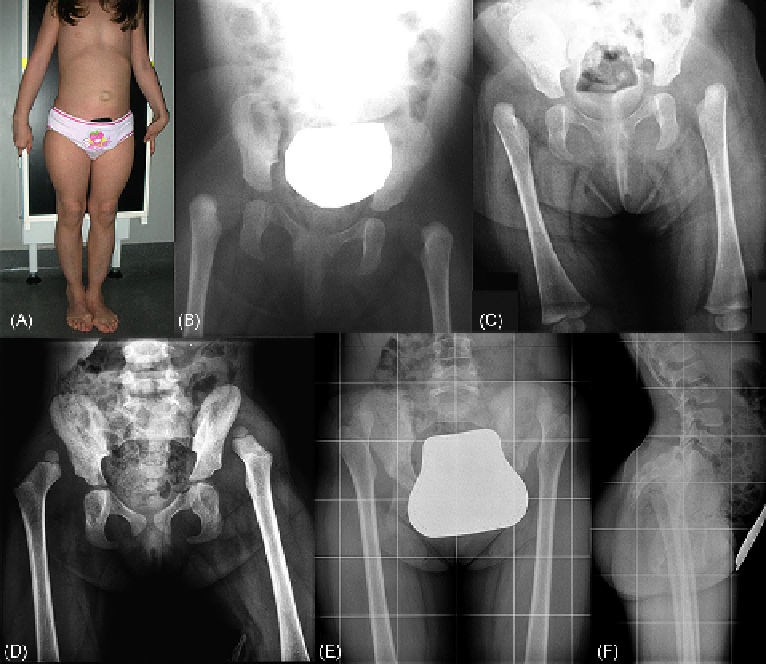what-when-how
In Depth Tutorials and Information
FIGURE 23.3
Clinical and radiological findings in a patient affected with EDS VIIB (Case 11), in whom hip dislocation was not surgically
corrected.
18
(A) The patient at age 9 years. Note marked lordosis and persistence of the umbilical hernia, lat feet with halux deformity. (B, C,
D and E) Radiograph of the pelvis at age 7 days (B), 5 months (C), 3 years (D) and 9 years (E). (F) Lateral view of the spine and pelvis showing
marked lumbar lordosis.
affected children. From published results, it appears
that the relative incidence of EDS VIIB is higher com-
pared to EDS VIIA, i.e., 26 to 11, respectively, although
the risk of a spontaneous mutation affecting exon 6 is
expected to be similar for both
COL1A1
and
COL1A2
genes. The reasons could be the difficulty in detecting
EDS VIIA by routine standard biochemical techniques,
35
as well as the possibility of clinical misdiagnosis (see
also “Genotype-Phenotype Correlation,” below, Cases
33-35).
Indeed, the clinical documentations clearly demon-
strate the severity of EDS VIIA and suggest that it is
more severe than EDS VIIB (
Table 23.1
), as expected by
the different stoichiometry of the α(I) chains. This state-
ment is supported by the more extensive ultrastructural
changes of the collagen fibrils, as well as by the com-
parison of the five personally examined patients with
EDS VIIB (Cases 4, 5, 7, 17 and 18). However, among
the reported cases of EDS VIIA, three involve substi-
tutions for the last nucleotide of exon 6 (Cases 33-35,
Table 23.1
). This results in two alternative splice vari-
ants, one in which the exon 6 sequence from mRNA
is completely deleted, and another in which normal
splicing is permitted, and the protein product contains
an isoleucine rather than a methionine at position 3 of
the first Gly-X-Y triplet of the triple helix. The normally
spliced product containing an amino acid substitution
diminishes the dysfunctional effect of three-quarters of
abnormal molecules; this results in a less severe clinical
phenotype which is indistinguishable from that of EDS
VIIB. In contrast, in Case 29, there is complete skipping
of exon 6 from mutant pro-α1(I) chains; this leads to
Genotype-Phenotype Correlation
Interfamilial and intrafamilial variability seems to be
slight. In EDS VIIB, the heterotrimeric collagen I mole-
cules consist of one population of normal collagen I and
one population of abnormal collagen I containing the
mutant pNα2(I) chain. In contrast, in EDS VIIA, three-
quarters of collagen I molecules would be expected to
be abnormal because they contain one or two mutant
pNα1(I) chains and, thus, the phenotype would be
expected to be more severe than that of EDS VIIB.

